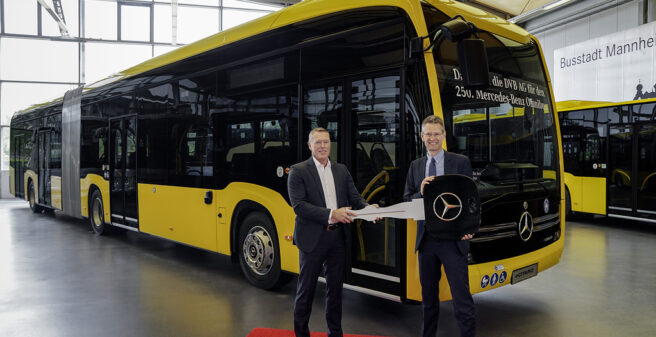
It runs through the city center and is very busy: City bus route 68 operated by Dresdner Verkehrsbetriebe (DVB) is part of the backbone of local public transport provided by buses in Saxony’s state capital. It has now been fully electrified – with the Mercedes-Benz eCitaro.
Daimler Buses electrifies Dresden’s bus fleet
DVB’s 22.3-kilometer-long 68 route runs from Goppeln to Niederwartha through the center of Dresden. By running the all-electric eCitaro, the primary objective is to help improve the local air quality. The route is also marked by a number of substantial inclines. Initially, eleven eCitaro G articulated buses will be used during the holiday schedule. Later, up to 16 eCitaro will be in use on working days. Dresdner Verkehrsbetriebe will be using two more eCitaro solo buses on route 81 on the outskirts of the city.
This will connect Dresden’s Neustadt with the important commercial and electronics sites in the north and is characterized by a particularly challenging topography.
In total, Dresdner Verkehrbetriebe has ordered 18 eCitaro G and two eCitaro buses. This means that around 15 percent of the bus fleet has now been fully electrified. The vehicles that have already been delivered have been undergoing intensive testing since June and have already covered more than 20,000 kilometers without any problems. The buses are then charged at the depot at night. In addition, charging is also carried out during the day at the route terminus using a pantograph.
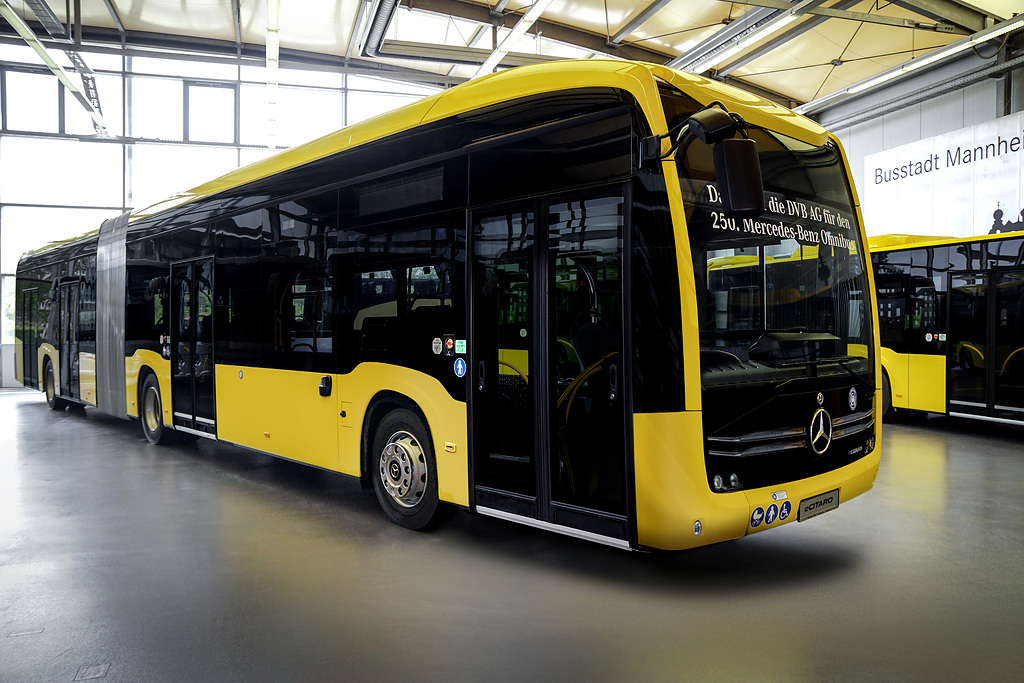
eCitaro equipment is both safe and convenient
DVB has prioritized both safety and convenience in its equipment. This becomes when looking at its articulated buses. Four doors ensure a rapid flow of passengers. At doors two to four, red flashing light strips and a buzzer warn immediately before closing, and the driver can also monitor doors three and four by CCTV. The interior of the buses also features CCTV.Passengers can sit on City Star Eco seats with fabric covers. Two special-purpose areas offer space for wheelchairs or pushchairs. The inside of the side walls is clad with homely looking needled felt. Two TFT screens are used to provide passenger information and passengers can enjoy their own entertainment using an on-board wireless network.
A driver’s door with a partition screen protects against the risk of infection, while a refrigerator box keeps beverages at the right temperature. Thanks to the Sideguard Assist turning assistant and the Preventive Brake Assist active brake assistant, the buses boast some exemplary safety equipment.
Dresdner Verkehrsbetriebe: around 150 buses on 29 routes
Dresdner Verkehrsbetriebe moves more than 500,000 passengers every day. Around a third of these use buses on 29 routes. The fleet consists of around 150 vehicles. Daimler Buses has been supplying the transport company since 1990. The 250th bus with the famous star was handed over in May 2022.Show lessAdd to the Download CenterDownload Filter
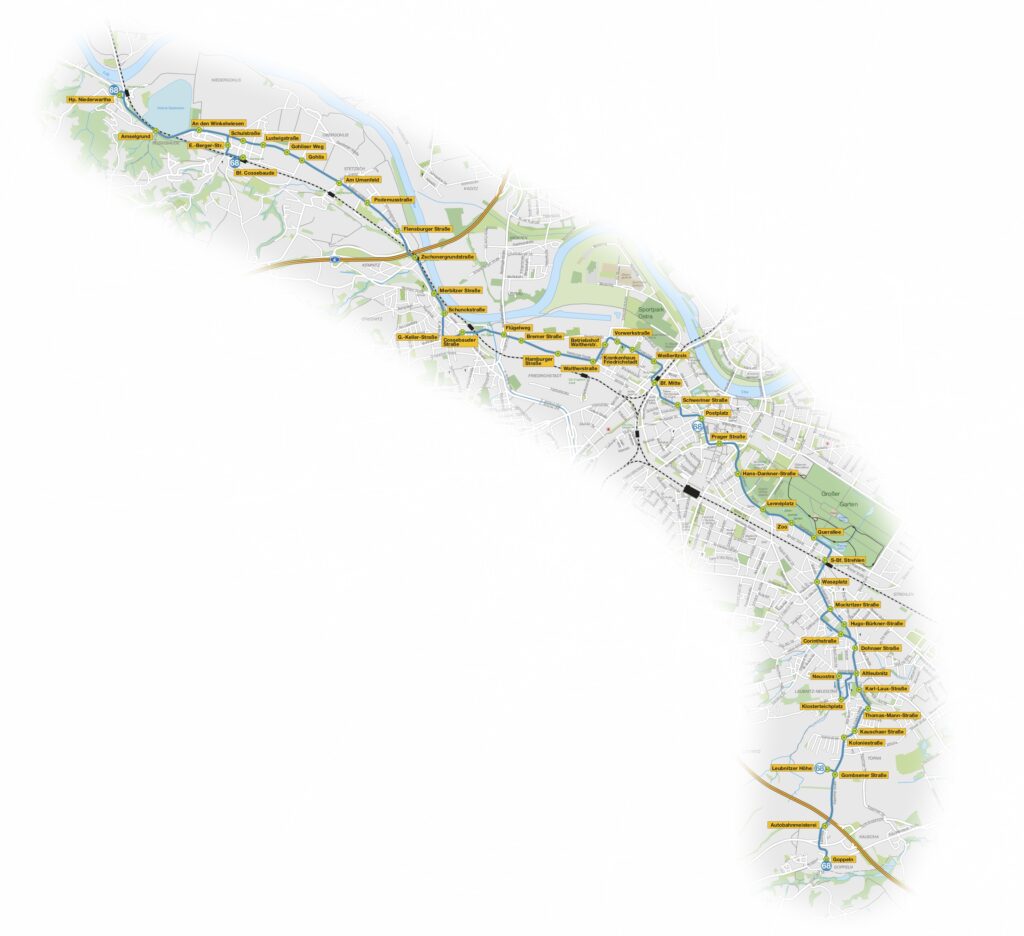
The operation
With the 22.3-kilometre bus line 68, a route was chosen for the conversion to all-electric operation that runs right through Dresden’s city centre. This is where the effects for climate protection are greatest. In addition, the line offers an interesting topography for e-bus operation with notable gradients. During the holiday timetable and due to a construction site shortly before Goppeln, 11 articulated buses are currently running on the line. Later, there will be up to 16 buses on weekdays.
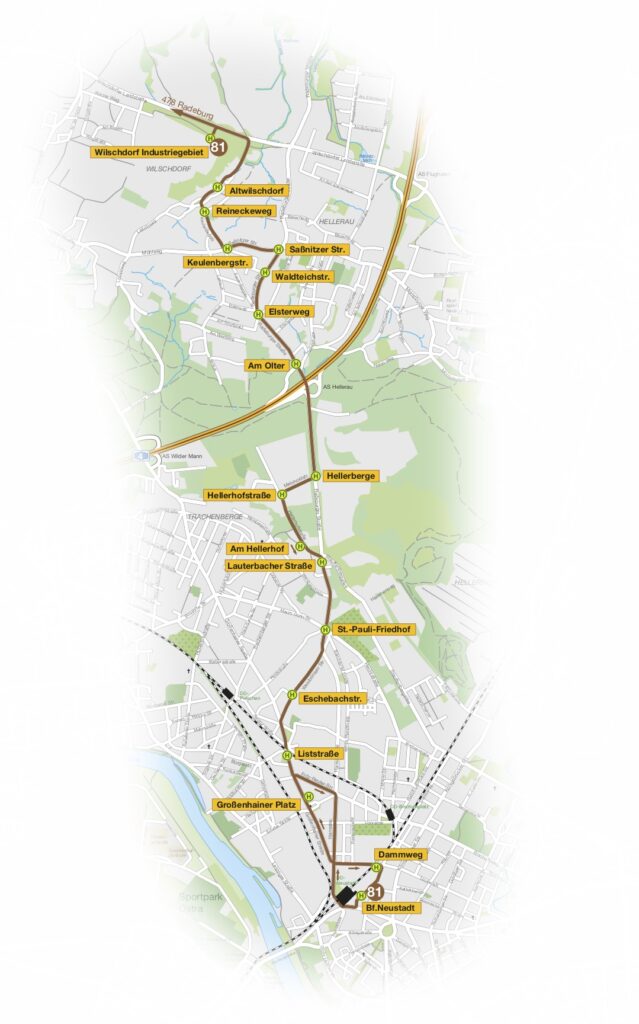
The 9.4-kilometre-long bus line 81, on which two 12-metre-long DVB electric buses are to be operated, runs representatively on the outskirts of the city. The line connects important commercial locations in the north with Neustadt station. It is operated jointly with VGM, whose buses are conventionally powered and travel further into the region from Wilschdorf.
Since mid-June 2022, the first e-buses have been tested in DVB’s regular service and have already covered 20,000 kilometres trouble-free. Some of them have been used for driver training.
Articulated E-buses in Dresden for the first time
With the eCitaro, battery-electric articulated buses are being used in Dresden for the first time. A total of twelve buses have already arrived at DVB and are ready for operation, seven have been announced by the factory for delivery at short notice. The last one will arrive in Dresden by the end of August. In the articulated bus there is space for 37 seated passengers and 104 standees, in the standard bus it its respectively 29 and 46. The buses weigh 20.6 and 13.8 tonnes respectively and have a permanent motor power of 285 kW and up to 500 kW as peak power. The drive is significantly quieter than that of a modern and well-insulated diesel bus. An electric heat pump is used for heating and cooling in the passenger compartment. At extremely low temperatures with double-digit minus degrees, the efficiency of heat pumps drops. In this case, a small auxiliary heater, which runs on heating oil or synthetic fuels, kicks in.
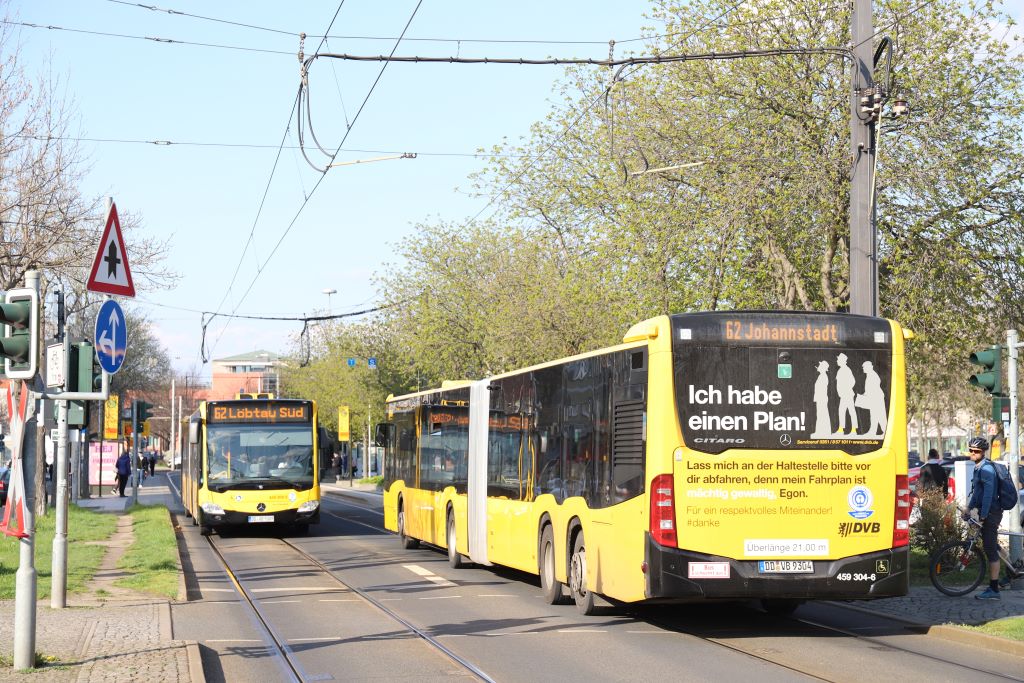
The storage units of the articulated e-bus consist of a total of ten lithium-nickel-manganese-cobalt (NMC) batteries, compared to eight for the standard bus. They are located in the rear of the vehicle and on the roof. The usable energy content is around 255 kWh for the articulated vehicle and 204 kWh for the standard bus. The batteries are permanently monitored by a diagnostic system and switch off automatically if localised heat builds up. This type of battery is considered fire-safe. The driver can view the most important on-board functions on an electronic display. For more road safety, the vehicles have an emergency brake assistant and a turn-off assistant.
Battery charging in the depot and at the end point
The electric buses receive their basic charge at night in the depot via charging bonnets under the hall ceiling, so that they can go on the line in the morning with a full battery. According to the manufacturer, this already gives them a range of at least 120 kilometres. However, because the buses run between 200 and 500 kilometres daily, they are recharged at selected end points. The current collector, a so-called pantograph, is folded out electrically and connects to a charging bonnet installed on site. The bus driver only has to position the trolley exactly under the bonnet.
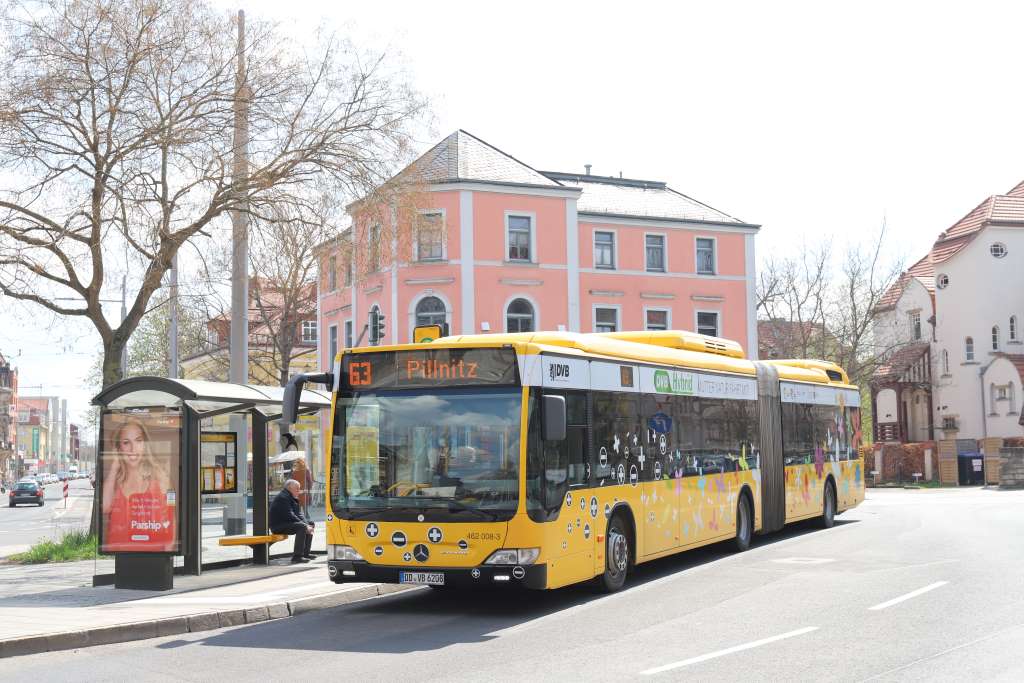
While the buses are charged slowly at night in the depot with a maximum of 150 kW and at low current, they are recharged at the end points with high current up to 300 kW. Five to ten minutes of turning time are then sufficient for the recharge. For every minute of recharging, the bus can travel another two to three kilometres. Together with the nightly basic charge, the vehicles can then easily get through the day.
Two charging stations are planned on line 68 at Leubnitzer Höhe and at Cossebaude station, and one in Wilschdorf on line “81”. The Leubnitzer Höhe station is already in operation, in Cossebaude the construction will start on 9 August 2022 and one week later the builders will start in Wilschdorf. All three charging stations should be ready for use by the end of August. The charging stations have been supplied by SBRS Charging Solutions, which is a subsidiary of Schaltbau AG.
Hybrid experience used
The experience gained with bus electromobility since 2007 has been incorporated into the procurement of the new ebus fleet. Since then, the first series-produced hybrid buses have been running in Dresden, and from 2015 DVB also had an all-electric bus in regular service. Both types of vehicles were scientifically accompanied in operation by graduates of the Technical University of Dresden and other universities. The expertise focused primarily on the sustainable and efficient use of the high-performance vehicle battery. Their technical development has made great progress in recent years.
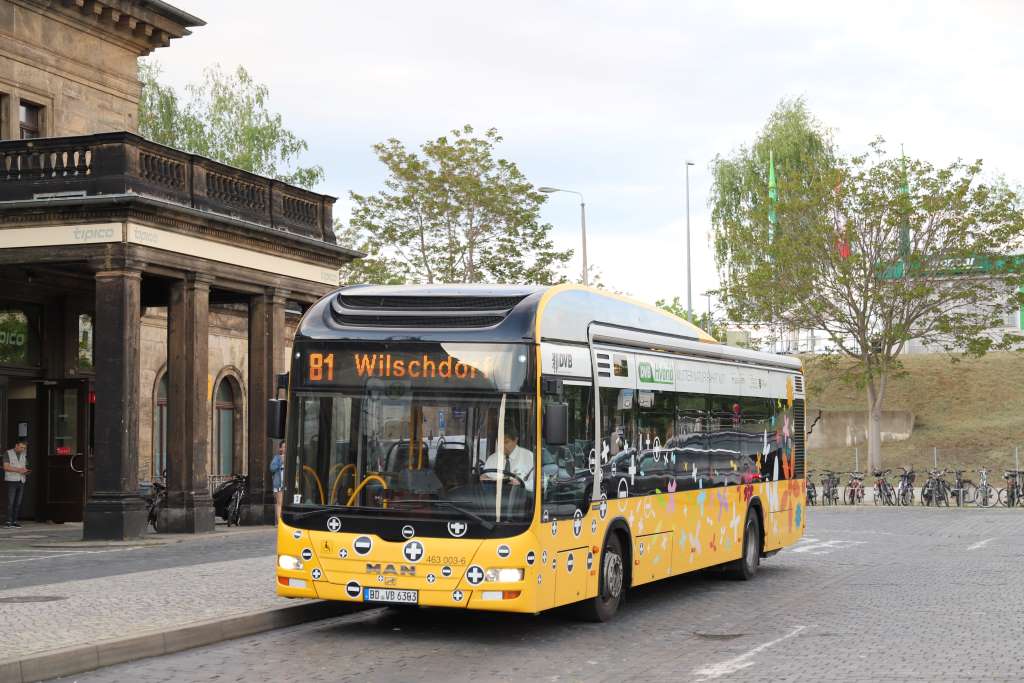
Investment in the future
DVB is investing €17.4 million in the 20 e-buses. A further €5.7 million will be spent on the charging infrastructure in the depot and at the terminals. DVB will receive €4.8 million in funding for the buses from the European Regional Development Fund (ERDF), the Saxon Ministry of Economic Affairs (SMWA) will provide a further €2.8 million for the infrastructure, and the Federal Ministry of Economics and Climate Protection (BMWK) will fund the additional costs of the electric drive compared to conventional diesel engines with a further €9.6 million. DVB is contributing €5.9 million of its own funds. Above all, the charging infrastructure is an investment in the future. In future, even more electric buses will be able to be charged there. The charging capacity has already been suitably dimensioned.
Dresden public transport electric in the long term
In accordance with the Act on the Procurement of Clean Road Vehicles, in which the requirements of the European “Clean Vehicles Directive” were transposed into German law, DVB intends to continue purchasing electric buses in the future. Due to the still very high costs, they are dependent on sufficient subsidies. The age of overhead line-free electric mobility in Dresden has also long since begun in the bus sector. With the new e-buses, 15 per cent of the DVB bus fleet is now purely electric.
Sources: Mercedes-Benz/ DVB/ SBRS Charging Solutions
18.08.2022
